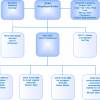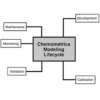Peter J. Jenks
the Jenks Partnership, Newhaven House, Junction Road, Alderbury, Salisbury, Wiltshire SP5 3AZ, UK
There is a perception amongst many involved with environmental analysis that the matrix effect is something that is an issue in elemental and inorganic analysis, but not much of a consideration when it comes to organic analysis. Unlike elemental analysis, where the analyte can be present in both natural form and from human activity, few organic analytes of interest are present naturally. This presumption leads to a belief that whilst organic analytes are easy enough to extract the analysis is the challenge.
Over the last three years many UK Environmental laboratories have been hard at work upgrading their ISI 17025 Accreditation as Testing Laboratories to meet the requirements of the UK Environment Agencies MCERTs Accreditation. To do this the labs have had to follow a rigorous method validation programme1 and in doing so have analysed many RMs and CRMs, not always with expected results. Review of the data from some of these method validation exercises has caused some to question established perceptions.
In the last edition of SE (Volume 19, No. 1, page 30) I argued that calcerious soils were not as easy to analyse as had been previously thought. Now it is the turn of organic analytes, specifically ubiquitous PAH group to come under scrutiny. The analysis of PAH in soil and water is nothing new, but over the last three months I’ve become aware of reports of under recovery of certain PAHs from soil and sediment samples. In one example data from the analysis of a CRM produced by a Cooperative Research and Development Agreement between RT Corp.2 and RIZA3 reported by labs in both the UK and the Netherlands was not as expected. All the labs reporting anomalous results found that although most PAHs gave results that were as expected some, including acenapthylene, anthracene and benzo(a)pyrene were giving reproducibly low recovery: typically 20–30 % of the certified value. At the same time other labs reported data that was, for the PAHs in question, as expected and very close to the certified value.
A recent web search showed that reports of this phenomenon were not limited to one CRM sold into the UK and Netherlands. From Canada, Claude Pelletier, an analytical chemist working for the Coastal Zones Research Institute in New Brunswick, Canada, reported problems: his lab has more than 10 years’ experience in PAH analysis, yet in a forum for Analytical Chemists he asked in late March 2007, if anyone had any idea why recently they got very low recovery on benzo(a)pyrene and perylene-d12, but not on other PAHs.4
I was asked by RTC to contact a number of end users of the CRM in question and find out exactly how they analysed their samples. A trend soon became clear: laboratories that experienced no difficulty with their PAH analysis had all used an aggressive extraction procedure that included mechanical agitation over an extended time and chlorinated solvents. Most of the labs experiencing problems had all tried to use non-chlorinated solvents and in many cases, soxhlet or accelerated extraction procedures.
It is worth note that in the literature there are good references to problems with PAH analysis, especially when the sample matrix is clay rich. One particularly interesting paper by T.F. Guerin in 19985 makes it very clear that aged PAH in clay rich soils can be strongly bound to the matrix and that the more polar PAHs, including benzo(a)pyrene, can be particularly difficult to remove. Guerin suggests that Using sonication over an 8 h extraction period, maximum extraction of the 16 US EPA priority PAH was obtained with dichloromethane (DCM)—acetone (1 + 1). The same procedure using hexane–acetone (1 + 1) recovered 86 % of that obtained using DCM–acetone (1 + 1). PAH recovery was dependent on time of extraction up to a period of 8 h. A number of the labs reporting low extraction from the RTC CRM were using an accelerated soxhlet extraction, without any dichloromethane in the extraction solvent mix.
Guerin goes on to conclude that “The type of solvent used, the length of time of extraction and extraction method influenced the quantification of PAH in the soil... The strong binding of PAH to soil, forming aged residues, has significant implications for extraction efficiency”.
There is no doubt that the very real pressures to eliminate the use of chlorinated solvents in routine laboratories, coupled with the ever present need to save time can conspire together to cause unexpected difficulties. In this instance the result has, once again, showed the importance of fully understanding the matrix effect.
References
- http://publications.environment-agency.gov.uk/pdf/GEH00203BKAY-e-e.pdf
- RT Corp., http://www.rt-corp.com
- RIZA, http://www.rijkswaterstaat.nl/rws/riza/home/english/index.html. The RIZA is the research and advisory body for the Rijkswaterstaat (the Directorate-General for Public Works and Water Management) for inland water in the Netherlands.
- http://www.chemicalforums.com/index.php?topic=13708.new
- T.F. Guerin, “The extraction of aged polycyclic aromatic hydrocarbon (PAH) residues from a clay soil using sonication and a Soxhlet procedure: a comparative study”, J. Environ. Monit. 1, 63–67 (1999). doi: https://doi.org/10.1039/a807307d










